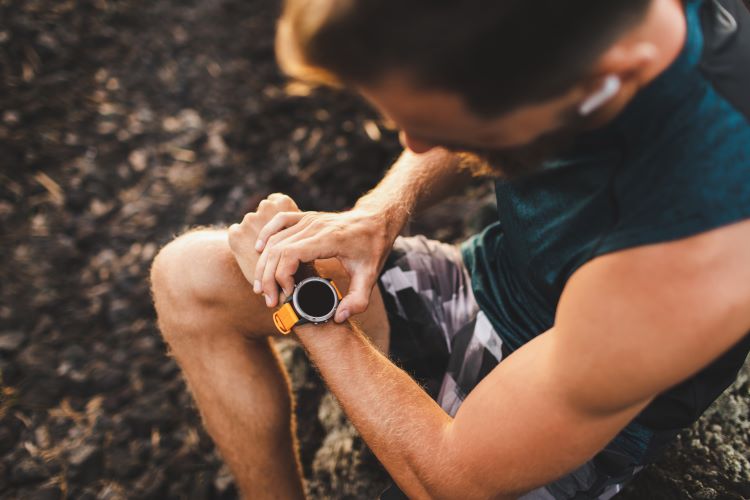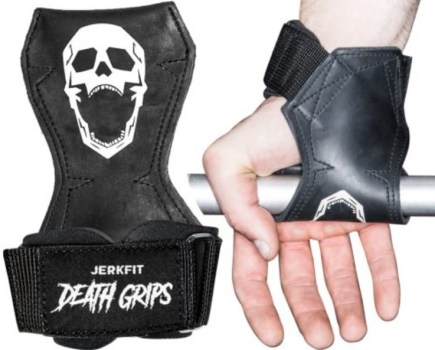Train more effectively, race stronger, and recover quicker with our pick of the best running watches on the market.
A good running watch is a powerful tool. The coaching elements can help fine-tune your training, measure your performance and progress, and boost motivation. Even the cheaper options now cover the basics, with reliable GPS, wrist-based heart rate tracking and loads of training, coaching and recovery insights to help you hit any goal.
What is the best running watch?
The Garmin Forerunner 965 is the best running watch I’ve tested. The ultra-crisp AMOLED touchscreen adds some user-friendly smartwatch style to Garmin’s market-leading training, performance and recovery insights. Accuracy across the board is generally impressive, and the week-long battery life caters for just about every level of runner.
Other running watch recommendations
| Best running watch on a budget | With the COROS Pace 3, COROS has added things we love to see like longer battery life, better GPS accuracy and some navigation smarts. For me, the Pace 3 builds on the bang-for-buck strength of the Pace 2 and I’d definitely recommend this highly for new runners, those on a budget or people looking for an unfussy watch that ticks the basic boxes – and goes a bit further to boot. |
| Best Polar running watch | The Polar Vantage V3 delivers a bright, smartwatch-style AMOLED display, multiband GPS with an upgraded chip, plus Polar’s new Gen 4 heart rate sensor setup that promises to boost the optical accuracy. The result is Polar’s best ever running watch. |
| Best AMOLED watch on a budget | The Suunto Race is an excellent watch for the price. The AMOLED screen is crisp; the breadth of training, navigation and health features is good; battery life is competitive; and GPS accuracy is largely on point |
| Best running smartwatch | The Apple Watch Ultra 2 sets the benchmark for smartwatches with running credentials. The native running experience now offers quite a lot of the training insights you’ll find on Garmin and if you’re willing to beef that up with third party apps it’ll do almost everything your Garmin, Polar or Suunto can do – just not in the same integrated fashion. |
Why you can trust Men’s Fitness
We spend hours testing every product or service we review, so you can be sure you’re buying the best. Find out more about how we test
1. Garmin Forerunner 965
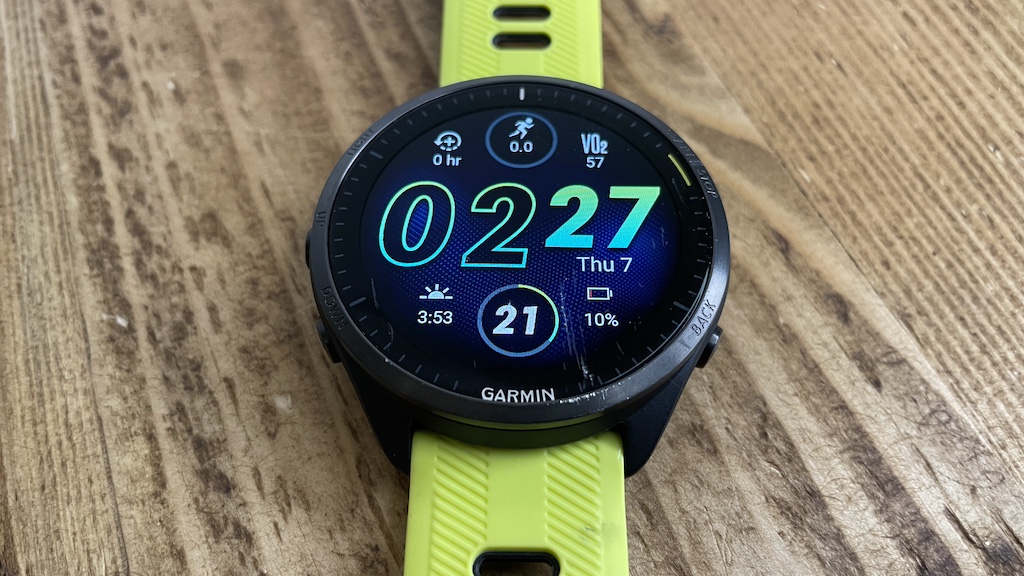
Men’s Fitness verdict
The ultra-crisp AMOLED touchscreen adds some user-friendly smartwatch style to Garmin’s market-leading training, performance and recovery insights. Accuracy and battery life are also impressive.- Large, bright display
- Multiband GPS
- Week-long battery life
- Screen prone to scratching (as shown in image above…)
- Price hike on the Forerunner 955
- Larger screen might not suit all wrists
| Display | AMOLED (optional always-on mode) |
| Display resolution | 454 x 454 pixels |
| Display size | 35.4mm (diameter) |
| Connectivity | Bluetooth, ANT+, WiFi |
| Weight | 52g |
Garmin has been top of the running watch tree for a little while, and for my money it stays there with the Forerunner 965 – the best running watch I had the pleasure of testing. It may be a lot more expensive that its predecessor but the host of upgrades make that extra outlay well worth it.
The large AMOLED touchscreen display looks great and makes the interface experience a dream. That’s partnered with big battery life, accurate GPS and a host of performance metrics that can genuinely enhance your running.
- Read more: Garmin Forerunner 965 review
2. COROS Pace 3

Men’s Fitness verdict
The Pace 3 builds on the bang-for-buck strength of the Pace 2. I’d highly recommend it for new runners, those on a budget or people looking for an unfussy watch that ticks the basic boxes.- Brilliant all-round value
- Reliable multi-band GPS
- Great battery life
- Design is a bit plastic and basic
- Patchy heart rate measurements
| Display | Touch screen always-on memory LCD |
| Display resolution | 240 x 240 pixels |
| Display size | 1.2 inches (diameter) |
| Connectivity | Bluetooth, WiFi |
| Weight | 39g with silicon band; 30g with nylon band |
It doesn’t boast the crystal-clear AMOLED display of the other running watches featured in this guide, but the COROS Pace 3 is more budget-friendly for it. And what it lacks in crispness it more than makes up for with a suite of run-boosting features. There aren’t many sub-£300 running watches where you’ll find features like blood oxygen level monitoring or a barometric altimeter.
Building on the impressive foundations of the COROS Pace 2, the Pace 3 brings in bigger batter life – I got 15.5 hours of GPS training out of it on a single charge – and accurate GPS in Dual Frequency Mode.
- Read more: COROS Pace 3 review
3. Polar Vantage V3
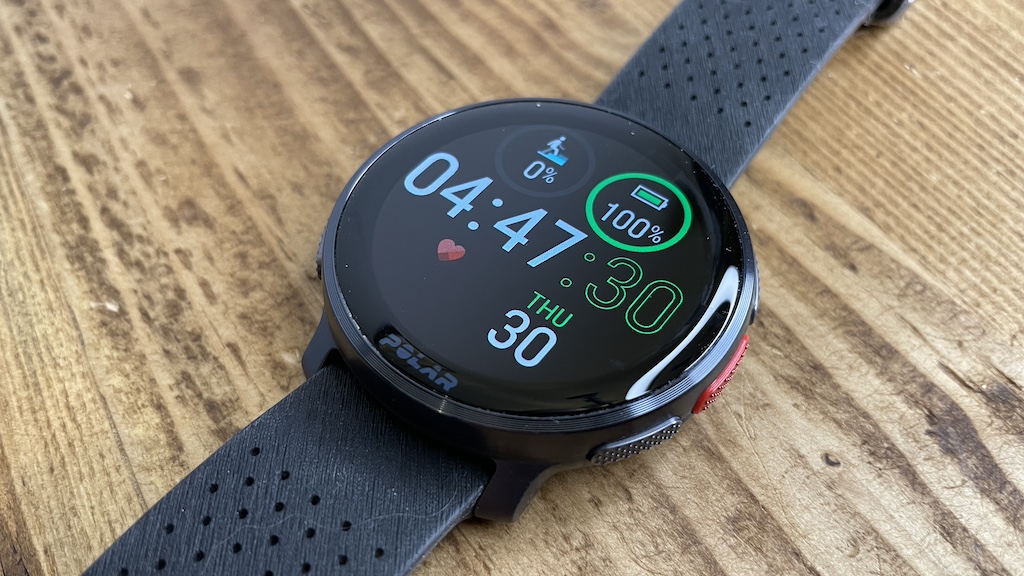
Men’s Fitness verdict
A bright smartwatch-style AMOLED display, multiband GPS with an upgraded chip, plus Polar’s new Gen 4 heart rate sensor makes for Polar’s best ever running watch.- Excellent, bright AMOLED display
- Reliable multiband GPS
- Free Komoot and Strava subscriptions
- Phone pairing and syncing is buggy
- Raise to wake is sometimes laggy
- No Spotify/Deezer playback
| Display | AMOLED |
| Display resolution | 454 x 454 pixels |
| Display size | 1.39 inches (diameter) |
| Connectivity | Bluetooth, ANT+ |
| Weight | 57g |
Polar is back with a bang with the Vantage V3, a great-looking running watch that does the basics very well, and introduces a few useful extras. Free Strava and Komoot subscriptions aren’t to be sniffed at either.
Wrist-based heart rate tracking still has a way to go, but I found the Vantage V3 provided one of the most reliably accurate heart rate measurements of any of the running watches I tested. The AMOLED display is big and bright, and the interface intuitive. Battery life is an improvement on previous models too.
- Read more: Polar Vantage V3 review
4. Suunto Race
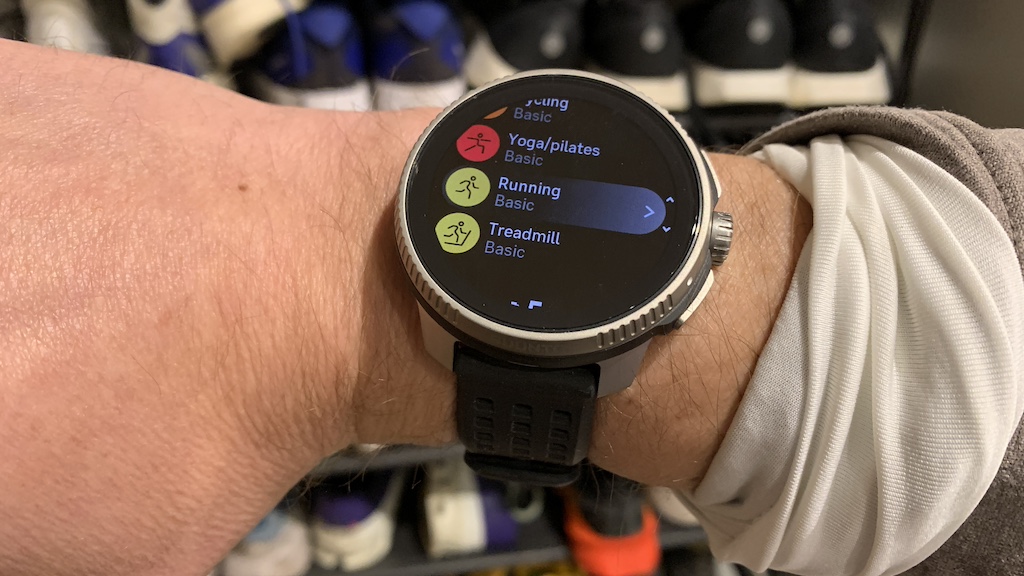
Men’s Fitness verdict
An excellent watch for the price. The AMOLED screen is crisp; the breadth of training, navigation and health features is good; battery life is competitive; and GPS accuracy is largely on point.- Excellent, bright, crisp display
- Good battery life for an AMOLED
- Software and touchscreen is laggy
- Stainless steel watch is bulky
| Display | AMOLED |
| Display resolution | 466 x 466 pixels |
| Display size | 1.43 inches (diameter) |
| Connectivity | Bluetooth, WiFi |
| Weight | 83g |
If Suunto has struggled to make a mark with its recent running watches, the Suunto Race represents a big step in the right direction. It’s a beast of a watch, with a huge display that’s easy to read and navigate on the run. Speaking of navigation, performance is a definite improvement over previous models thanks to multiband, dual frequency GPS.
Battery life is impressive, too, especially given the size of screen that needs powering, and it’s considerably cheaper than the other AMOLED options in this list.
- Read more: Suunto Race review
5. OnePlus Watch 2
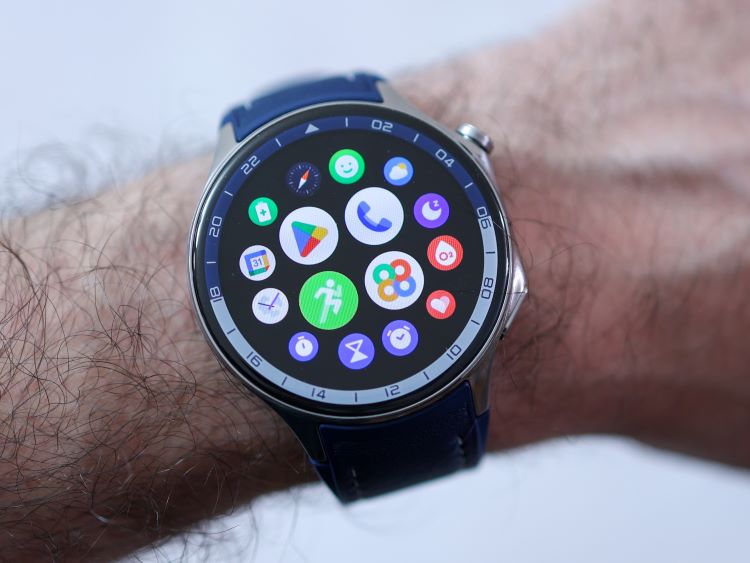
Men’s Fitness verdict
Despite missing a few tricks, the OnePlus Watch 2 solves the age-old issue of poor WearOS battery life. With its stylish design and tracking smarts it’ll make an all-day fitness-focused wearable too.- Robust with refined styling
- Runs smart apps
- Great battery (for a Wear OS watch)
- No ANT+ HR broadcasting
- Imperfect sleep tracking
- Rotating crown doesn’t scroll
| Display | AMOLED |
| Display resolution | 466 x 466 pixels |
| Display size | 1.43 inches (diameter) |
| Connectivity | Bluetooth, WiFi |
| Weight | 80g |
OnePlus has to be the first WearOS to provide us with usable multi-day battery performance in the Watch 2. It’s perhaps the most stylish looking watch on test and works in two modes to optimize battery life. In Smart mode you have access to all its fitness functionality and to third-party apps with a four-day batter life. In Power Saver mode that life extends to 12 days, with access to the watch’s built-in apps, sports modes and tracking features.
Sleep and heart rate tracking are decent and despite its svelte appearance it’s robust enough to withstand the rigors of adventurous workouts too.
- Read our full OnePlus Watch 2 review
6. Apple Watch Ultra 2
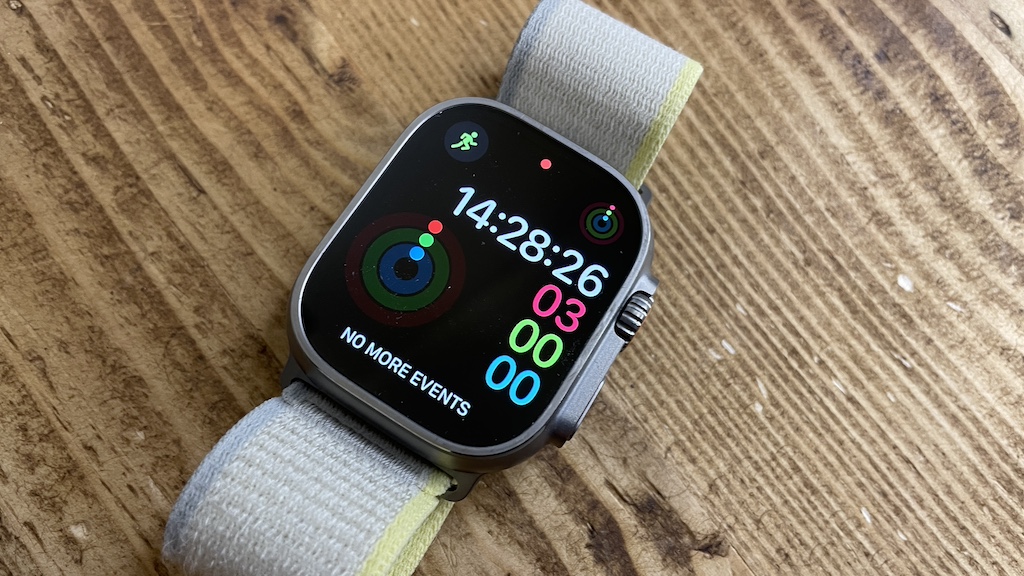
Men’s Fitness verdict
If you want a brilliant smartwatch – the best in the business – that also has good running credentials, this is it. But if you want the best running watch, you can get more for your money.- Best smartwatch battery life
- Stunning, rugged design
- Accurate heart rate and GPS
- Very expensive
- Battery life still short for a running watch
| Display | Retina LTPO OLED, 3000 nits (peak) |
| Display resolution | 502 x 410 pixels |
| Display size | 1.92 inches (diameter) |
| Connectivity | Bluetooth, WiFi |
| Weight | 61.4g |
If you want a smartwatch you can do a bit of running with, and have a big budget to play with, look no further than the Apple Watch Ultra 2. For day-to-day tracking and smartwatch features, Apple continues to be well out in front.
However, there are better – and cheaper – watches available if you want to go deep diving into your running metrics. And not many people buy Apple Watches for their battery life. But for smartwatch features and the best screen in the business, Apple still takes some beating.
- Read more: Apple Watch Ultra 2 review
7. Garmin Forerunner 165 Music
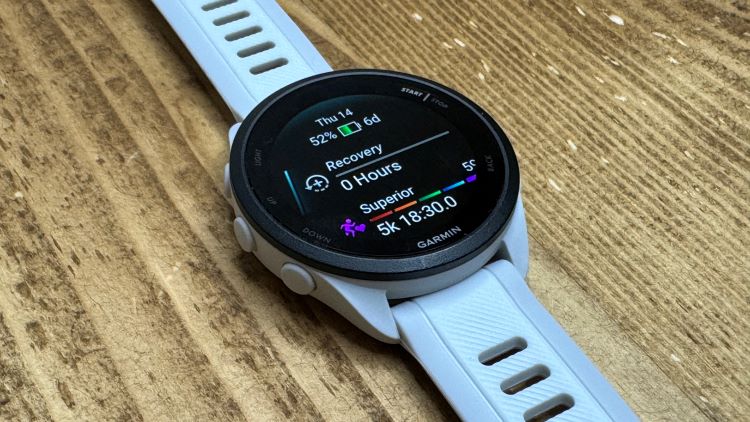
Men’s Fitness verdict
The offline music, sleek design and AMOLED display make this Forerunner a sound proposition, but there’s no escaping that lower-than-average battery life.- Excellent bright display
- Comfortable, compact design
- Offline music
- Battery life not class leading
- Missing some training insights
| Display | Color AMOLED touchscreen |
| Display resolution | 390 x 390 pixels |
| Display size | 1.2 inches (diameter) |
| Connectivity | Bluetooth, WiFi |
| Weight | 39g |
With the Forerunner 165 Music, Garmin looks to be setting a new benchmarks for budget running watches. For under $300 you still get most of the significant training insights found on its pricier watches, as well a bright, crisp 1.2-inch AMOLED screen – not to mention the ability to play music offline.
The one concession is a rather average battery life, which you might need to manage, especially if you plan on playing music on most of your runs. But if your running routine can cope with that, you’re getting a great value running watch with plenty of high-end features.
- Read more: Garmin Forerunner 165 Music review
8. Polar Grit X2 Pro
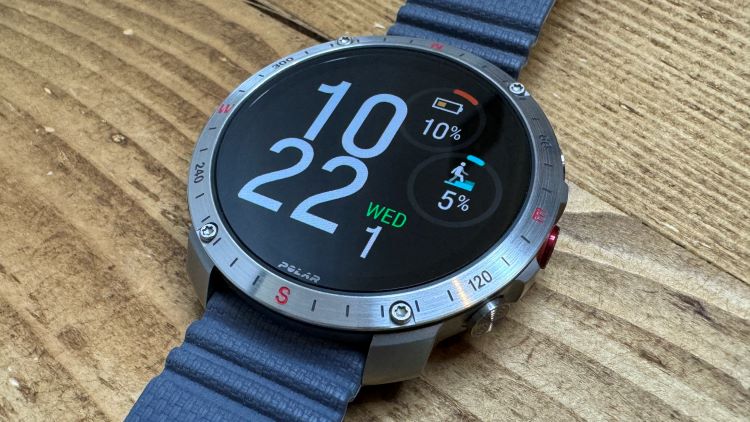
Men’s Fitness verdict
The new Polar Grit has all the tracking modes, insights and accuracy you could need for training, racing and off-grid adventures. It’s just a little lacking in smartwatch features.- Stunning bright display
- Comprehensive navigation tools
- Long battery life
- Flaky app connectivity
- Low on smartwatch features
| Display | AMOLED |
| Display resolution | 466 x 466 pixels |
| Display size | 1.43 inches (diameter) |
| Connectivity | Bluetooth, WiFi |
| Weight | 83g |
The Polar Grit X2 Pro is Polar’s top-end, toughened, adventure-ready GPS sports watch. It’s built to handle all your training, racing and exploring endeavors on and off the grid. This latest upgrade adds a punchy AMOLED display, accuracy-enhancing dual frequency GPS, Polar’s latest biosensors and a snappier performance.
Throw in new navigation skills with offline maps, Strava route sync and breadcrumb navigation and improved battery life over the OG Grit and you’ve now got a strong rival to the like of the Garmin Fenix.
- Read more: Polar Grit X2 Pro review
How we tested the best running watches
Kieran Alger is an ultramarathon runner and professional product tester. He ran with each of these watches for a minimum of four weeks, across a range of distances near his base in West London.
What makes a good running watch?
The best running watches get the basics right, with accurate heart rate, fast satellite link-up and reliable GPS tracking for pace and distance. Along with good runtime GPS battery life, these are the non-negotiables. The good news: you can now find these essentials in even the cheapest running watches.
A good running watch boasts a bright, clear, crisp screen that’s easy to read in all light conditions, particularly on the move. There’s a big trend for AMOLED screens, with all the major brands, Polar, Suunto and Garmin adding these Apple-esque super-sharp displays to their mid-to-premium watches. Though you might sacrifice the longest battery life for that pleasure.
Customization of your mid-run stats and post-run watch faces is also very handy. And the best watches offer zippy interfaces and responsive controls and touchscreen. You don’t want to be jabbing at unreactive buttons when you’re trying to take your splits.
When it comes to training insights, the best watches now track a huge array of metrics and offer up a broad sweep of feedback. That ranges from post-run training effect, the build-up of fatigue and recovery time recommendations, to heart rate variability, blood oxygen levels, daily stress, sleep and even ECG.
You might look for lifestyle health tools like sleep tracking and training readiness scores, but be warned: almost all of the sleep trackers lack accuracy, and the readiness scores that often rely on sleep data are fallible, too.
Rugged design options
If you’re heading off grid onto the trails, or you plan to run an ultra, the bigger, rugged adventure running watches like the Garmin Fenix 7 and COROS Vertix 2 offer more robust design, longer battery life and more powerful navigation tools.
If navigation is a priority, route planning with breadcrumb navigation is a given. But more capable watches offer turn-by-turn navigation, offline topographical maps and clever features like back-to-start, elevation profile and waypoint marking.
Smartwatch skills are improving and most watches now let you read notifications, text and call alerts. If music is important, some let you control your smartphone music players, but the better watches offer offline music storage, and play nice with streaming services like Spotify and Deezer.
The app and web training tools are also important, and Polar Flow differs greatly from Garmin Connect or the COROS and Suunto apps. If you’re a first-timer with these, it’s smart to download them first (they’re free) and have a play with them before you buy the watch. These partner training tools can be a big part of the overall experience so it’s worth the time invested.

